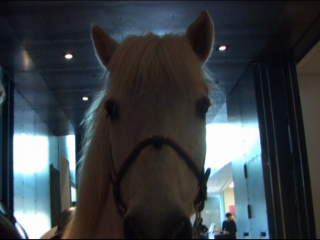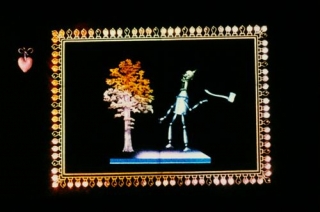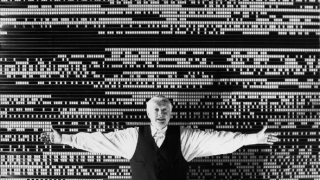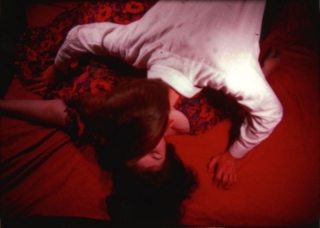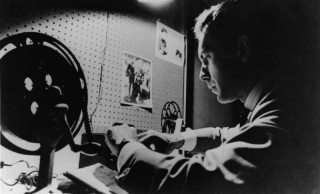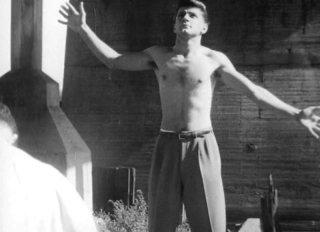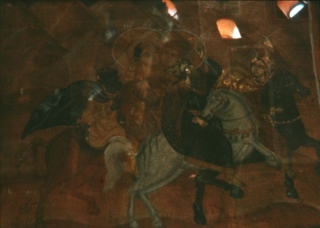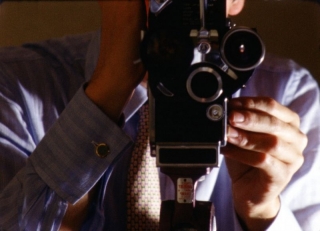Date: 24 January 2013 | Season: Jonas Mekas
SLEEPLESS NIGHTS STORIES
Thursday 24 January 2013, at 6:10pm
London BFI Southbank NFT2
Mekas’ opening confession that he suffers from insomnia will come as no surprise to anyone aware of his singular contribution to cinema. Eating, drinking, singing and dancing with friends, the tireless octogenarian is full of life and wonder, casually weaving together contemporary folk tales collected during travels across the globe. Treating significant and inconsequential moments with equal import, this modern day saga presents the first episodes from a proposed ‘1001 Nights’ project.
Jonas Mekas, Sleepless Nights Stories, USA, 2011, 114 min
with Marina Abramovic, Louis Garrel, Harmony Korine, Patti Smith
Also screening Saturday 26 January at 8:40pm.
Date: 28 January 2013 | Season: Anthology Film Archives, Jonas Mekas
ANTHOLOGY FILM ARCHIVES AND ESSENTIAL CINEMA PROGRAMME 4
Monday 28 January 2013, at 8:30pm
London BFI Southbank NFT2
Surrealism and the poetic sensibility were amongst the defining traits of the post-war avant-garde. In 1947, the teenage Kenneth Anger drew inspiration from Jean Cocteau to make Fireworks, a bold, astounding, homoerotic vision. Pull My Daisy was narrated by Jack Kerouac and includes Allen Ginsberg, Alice Neel and Delphine Seyrig among its illustrious cast. The programme concludes with fragments from Harry Smith’s abandoned Wizard of Oz project.
Willard Maas, Geography of the Body, 1943, 7 min
Douglas Crockwell, Glen Falls Sequence, 1937-46, 8 min
Kenneth Anger, Fireworks, 1947, 20 min
Ed Emshwiller, Thanatopsis, 1962, 5 min
Robert Frank & Alfred Leslie, Pull My Daisy, 1959, 28 min
Harry Smith, Oz: The Tin Woodman’s Dream, 1967, 15 min
Date: 9 April 2013 | Season: London Film Festival 2012 | Tags: Peter Kubelka
PETER KUBELKA PRESENTS MONUMENT FILM
Tuesday 9 April 2013, at 6:30pm
London BFI Southbank NFT1
Peter Kubelka, Monument Film, Austria, 1960/2012, c.90 min (lecture screening)
The Austrian filmmaker Peter Kubelka has been a vital and uncompromising force in cinema for more than half a century. In a body of work that lasts not much more than an hour in total, he condenses and articulates the essential qualities of analogue cinema, distinguishing film as an autonomous artform. His 1960 film Arnulf Rainer, composed only of the purest elements of light and darkness, sound and silence, remains one of the most radical achievements in film history. In response to that earlier work, his new film Antiphon was revealed in 2012 as part of Monument Film, a powerful testament to the entire medium. With two 35mm projectors situated in the auditorium, each film is screened individually, then combined as double projections, both side-by-side and superimposed upon each other. Throughout this extraordinary projection event, Peter Kubelka will discuss his theories, explaining the differences between film and digital media, and articulating his belief in the survival of cinema.
Curated by Mark Webber. Presented with the support of the Austrian Cultural Forum, London. This performance was originally scheduled for the 56th BFI London Film Festival last October.
Date: 2 August 2014 | Season: Gregory Markopoulos: Film as Film | Tags: Gregory Markopoulos
THE ILLIAC PASSION
Saturday 2 August 2014, at 2pm
Guanajuato Teatro Juarez
Gregory J. Markopoulos (1928-92) was one of the most original filmmakers to emerge from the post-war avant-garde. His films, which often translated literary or mythological sources to a contemporary context, are celebrated for their extraordinary creativity, the sensuous use of colour and innovations in cinematic form. In the 1960s, Markopoulos was actively involved in New York’s vibrant film community – the same milieu in which landmark works such as Scorpio Rising (Kenneth Anger), Flaming Creatures (Jack Smith) and The Chelsea Girls (Andy Warhol) first enraptured audiences. It was here that Markopoulos made one of his most celebrated films, The Illiac Passion, an extravagant interpretation of ‘Prometheus Bound’ populated with fantastic characters from the underground scene. Warhol appears as Poseidon, alongside Beverly Grant, Taylor Mead, Jack Smith, and other important figures. The soundtrack of this visionary re-imagining of the classical realm features a fractured reading of Thoreau’s translation of Aeschylus and excerpts from Bartók.
Gregory J. Markopoulos, The Illiac Passion, 1964-67, 92 min
This rare screening of The Illiac Passion celebrates the publication of Film as Film: The Collected Writings of Gregory J. Markopoulos (The Visible Press, 2014) and will be introduced by the book’s editor Mark Webber.
Also screening: 5 August 2014 at Mexico City Centro de Cultura Digital
PROGRAMME NOTES
THE ILLIAC PASSION
Saturday 2 August 2014, at 2pm
Guanajuato Teatro Juarez
THE ILLIAC PASSION
Gregory J. Markopoulos, USA, 1964-67, 16mm, sound, colour, 92 minutes
Inspired by Aeschylus’ Prometheus Bound. Music by Béla Bartok (excerpt from Cantata Profana). Voiceover by Gregory Markopoulos, reading from the American translation of Prometheus Bound by Henry David Thoreau. Costumes by Jerome Hiler.
Cast: Richard Beauvais (Prometheus), David Beauvais (his conscience), Robert Alvarez (Narcissus), Taylor Mead (the Demon or Sprite), Sheila Gary (Echo), Peggy Murray (the Muse), Tom Venturi (Hyacinthus), Tally Brown (Venus), Kenneth King (Adonis), gerard Malanga (Ganymede), Jack Smith (Orpheus), Jan Chipman (Eurydice), Andy Warhol (Poseidon), Phillip Klass (Daedelus), Margot Brier (Pandora), Paul Swan (Zeus), Wayne Weber (Icarus), Carlos Anduze (Hades), Stella Dundas (Moon Goddess), John Dowd (Endymion), Philip Marker (Apollo), Beverly Grant (Persephone / Demeter), Clara Hoover (Io), Gregory Battcock (Phaeton), and Gregory Markopoulos (as himself).
Back to top
Date: 8 September 2014 | Season: Gregory Markopoulos: Film as Film | Tags: Gregory Markopoulos
GREGORY J. MARKOPOULOS: FILM AS FILM
8—13 September 2014
New York Anthology Film Archives
“There is no language. There is no art. There is no knowledge. There is but film as film: the beginning and the eternal moment.” (The Intuition Space, 1973)
Gregory J. Markopoulos (1928-92) is one of the most original filmmakers to emerge from the post-war avant-garde. His films, which often translated literary or mythological sources to a contemporary context, are celebrated for their extraordinary creativity, the sensuous use of color and innovations in cinematic form. A co-founder of the New American Cinema Group, Markopoulos was actively involved in nurturing New York’s film community before moving to Europe at the end of the 1960s to pursue a more individual path. Firmly believing that a filmmaker should be responsibility for all aspects of his work, he developed the idea of Temenos, a monographic archive for the preservation, presentation and study of his films.
In parallel to his filmmaking, Markopoulos was a prolific writer whose articles were circulated in journals, self-published editions or program notes. This screening series celebrates the publication of Film as Film: The Collected Writings of Gregory J. Markopoulos, a new book that gathers together some ninety out-of-print or previously unavailable texts by the filmmaker. See www.thevisiblepress.com for more information on the book, and for details of additional events at Light Industry, The Kitchen, Harvard Film Archive and elsewhere this fall.
This is an extremely rare opportunity to see Markopoulos’ earliest works, shown alongside some of the first films made in Europe following his departure from the US in 1967. Robert Beavers and Mark Webber (the editor of “Film as Film”) will be present and the book will be available for purchase at the programmes.
Date: 8 September 2014 | Season: Gregory Markopoulos: Film as Film | Tags: Gregory Markopoulos
GREGORY J. MARKOPOULOS: FILM AS FILM 1
Monday 8 September 2014, at 7:30pm
New York Anthology Film Archives
Made as a USC student in Los Angeles, Markopoulos’ first 16mm film Psyche took as its source the unfinished novella of the same name by Pierre Louÿs. Shown together with Lysis and Charmides (both made on his return to Toledo, Ohio, and inspired by Platonic dialogues), it forms the trilogy titled Du sang de la volupte et de la mort (1947-48). By boldly addressing lesbian and homosexual themes, the trilogy gained unwelcome notices in Films in Review and Variety where, in the repressive atmosphere of the early 1950s, it was branded “degenerate” following a screening at NYU. Such a response is unimaginable today for lyrical works that express sensuality through the symbolic use of color and composition. Writing about these early films, Markopoulos chose to quote a statement by philosopher and theologian Mircea Eliade, offering viewers a clue to his entire body of work: “The whole man is engaged when he listens to myths and legends; consciously or not, their message is always deciphered and absorbed in the end.”
Gregory J. Markopoulos, A Christmas Carol, 1940, 5 min
Gregory J. Markopoulos, Du Sang, de la volupté et de la mort, 1947-48, 70 min (Essential Cinema)
Gregory J. Markopoulos, Christmas USA, 1949, 8 min
“The first thing which I did was to delete the novelette of its lush rhetoric and retain only its symbolic color. In Psyche, color plays an important role, similar to the role which color plays in the paintings of Toulouse Lautrec. Color reflects the true character of the individual before us, whether it be on the screen, in a painting, or in the street. Color is Eros.” (Psyche’s Search for the Herb of Invulnerability, 1955)
Date: 9 September 2014 | Season: Gregory Markopoulos: Film as Film | Tags: Gregory Markopoulos
GREGORY J. MARKOPOULOS: FILM AS FILM 2
Tuesday 9 September 2014, at 7:30pm
New York Anthology Film Archives
The Mysteries was made in Munich, Spring 1968, during the same period in which Markopoulos directed two opera pieces for German television. (Rosa von Praunheim was his assistant on all three projects.) Writing in Artforum, Kristin M. Jones described the film as “… a mournful work in which, as in many of the earlier films, the rhythmic repetition of imagery evokes poetic speech, and changes in costume emphasize shifts in time, space, and emotion. Here, a young man’s struggles with memories of love and intimations of death are set alternately to deafening silence and the music of Wagner.” The Swiss chateau built for Wagner by King Ludwig II is documented in Sorrows, an in-camera film composed through intricate layers of superimposition.
Gregory J. Markopoulos, Sorrows, 1969, 6 min
Gregory J. Markopoulos, The Mysteries, 1968, 80 min
“In my film I suggest that there is no greater mystery than that of the protagonists. War and Love are simply equated for what they are; the aftermath is inevitable, and a normal human condition, for which like the ancients one can only have pity and understanding. In this lies the mystery. All else is irrelevant. That there are other sub-currents of equal power in The Mysteries goes without saying; and, those who are capable of the numerous visual visitations and annunciations which the film offers them will realize what is the Ultimate Mystery of my work.” (Disclosed Knowledge, 1970)
Date: 10 September 2014 | Season: Gregory Markopoulos: Film as Film | Tags: Gregory Markopoulos
GREGORY J. MARKOPOULOS: FILM AS FILM 3
Wednesday 10 September 2014, at 7:30pm
New York Anthology Film Archives
“To be loved means to be consumed. To love means to radiate with inexhaustible light. To be loved is to pass away, to love is to endure.” (Text by Rainer Maria Rilke, recited on the soundtrack of Gammelion.)
Markopoulos’ elegant film of the castle of Roccasinibalda in Rieti, Italy, (then owned by patron, publisher and activist Caresse Crosby) employs an intricate system of fades to extend five minutes of footage to an hour of viewing time. This inventive new film form, in which brief images appear amongst measures of black and clear frames, was a crucial step towards Markopoulos’ monumental final work Eniaios (1947-91). This screening of Gammelion will be preceded by Bliss, a portrait of the interior of a Byzantine church on the Greek island of Hydra, edited in-camera in the moment of filming.
Gregory J. Markopoulos, Bliss, 1967, 6 min
Gregory J. Markopoulos, Gammelion, 1968, 55 min (Essential Cinema)
“Fortunate is the filmmaker who possesses a daemon, and who passes naturally from season to season, always with renewed energies, to that crucial point where he is able to recognize what constitutes the sunken attitudes of his art; what constitutes the portent, eagle-shaped attitudes. Attitudes which in a season of plenty soar beyond the frailties and grievances of the creative personality. Forgotten and released are the self-acknowledged limitations, the often comical, continuous demands upon friends and acquaintances in the name of one’s art. Finally, the total illusion that has been inherent from the beginning in one’s striving shimmers, quivers, and sets one aflame.” (Correspondences of Smell and Visuals, 1967)
Date: 11 September 2014 | Season: Gregory Markopoulos: Film as Film | Tags: Gregory Markopoulos
MARKOPOULOS/BEAVERS: EXPERIMENTAL FILMS/EXPERIMENTAL LIVES
Thursday 11 September 2014, at 7pm
New Haven Yale Whitney Humanities Center
Introduced and followed by a conversation with Mark Webber and Robert Beavers.
Gregory J. Markopoulos, Christmas USA, 1949, 8 min
Gregory J. Markopoulos, Through a Lens Brightly: Mark Turbyfill, 1967, 15 min
Robert Beavers, Early Monthly Segments, 1968-70/2000, 33 min
Gregory J. Markopoulos, Gilbert and George, 1970/1989-91, 12 min
Robert Beavers, Listening to the Space in My Room, 2010, 19 min
Presented by the Yale Film Studies Program, Hellenic Studies Program, Yale Film Colloquium, and Films at the Whitney.
PROGRAMME NOTES
MARKOPOULOS/BEAVERS: EXPERIMENTAL FILMS/EXPERIMENTAL LIVES
Thursday 11 September 2014, at 7pm
New Haven Yale Whitney Humanities Center
CHRISTMAS U.S.A.
Gregory J. Markopoulos, 1949, 16mm, 8 min
“The film is a subtly joyous depiction of sexual and sensual awakening – a celebration of a young man’s discovery of strange, exciting things lurking beyond the drab normality of the everyday. It’s a specific metaphor for Markopoulos’ homosexuality, of course, but also more generally for the sexual and intellectual awakenings of adolescence, the escape from the family to the individual life. That Markopoulos populates this moment with such wonder, passion, and mystical tension is a testament to his sure-handed ability to convey complex emotions cinematically, even at this early stage of his career.” (Ed Howard)
THROUGH A LENS BRIGHTLY: MARK TURBYFILL
Gregory J. Markopoulos, 1967, 16mm, colour, sound, 15 min
“One of the most accomplished works in Markopoulos’s series of film portraits, Through a Lens Brightly is a vivid study of the dancer and poet Mark Turbyfill that uses paintings and photographs in his home to recapture and illuminate a life in the arts.” (Harvard Film Archive)
EARLY MONTHLY SEGMENTS
Robert Beavers, 1968-70/2000, 35mm, colour, silent, 33 min
“Early Monthly Segments, filmed when Beavers was 18 and 19 years old, now forms the opening to his film cycle, “My Hand Outstretched to the Winged Distance and Sightless Measure.” It is a highly stylized work of self-portraiture, depicting filmmaker and companion Gregory J. Markopoulos in their Swiss apartment. The film functions as a diary, capturing aspects of home life with precise attention to detail, documenting the familiar with great love and transforming objects and ordinary personal effects into a highly charged work of homoeroticism.” (Susan Oxtoby)
GILBERT AND GEORGE
Gregory J. Markopoulos, 1970/1989-91, 16mm, colour, silent, 12 min
“Gregory Markopoulos’ Gilbert and George (1970) is a film marked by absence. Though a portrait of the artistic duo, the film indulges in none of the privileging of visibility on which the genre of portraiture often rests. Much of its twelve-minute duration is filled not with likenesses of the artists but with black and white leader. Occasionally a flash of image – a pair of feet, for example – will fill the screen for a brief moment before retreating again. The flow of movement, so crucial to most films, is missing. In its place is a rigorous engagement with the medium’s most basic elements, one that returns the viewer to the stillness of the individual film frame.” (Erika Balson)
LISTENING TO THE SPACE IN MY ROOM
Robert Beavers, 2010, 16mm, colour, sound, 19 min
“Ostensibly a portrait of a place where the artist had resided until recently, the film conjures not only the memory but also the physical presence of those who have previously stayed there. Adhering to a solitary intimacy while simultaneously acting as an ode to human endeavour and shared impulses toward fulfillment through art, Listening to the Space in my Room is a moving testament to existence (whose traces are found in literature, music, filmmaking, gardening) and our endless search for meaning and authenticity. The film’s precise yet enigmatic sound-image construction carries a rare emotional weight. ” (Andréa Picard)
Back to top
Date: 13 September 2014 | Season: Gregory Markopoulos: Film as Film | Tags: Gregory Markopoulos
GREGORY J. MARKOPOULOS: FILM AS FILM 4
Saturday 13 September 2014, at 3pm
New York Anthology Film Archives
Inspired by the legend of Faust, Genius is a triple-portrait of three significant art world figures – the British artist David Hockney, the Argentinian surrealist painter Leonor Fini, and the German-born art dealer Daniel-Henry Kahnweiler, an important early supporter of the Cubists. With its measured structure, carefully spacing images between passages of clear or opaque film, Genius forms the central section of the third cycle of Eniaios. This 80-hour long silent film, one of the most remarkable and ambitious projects in the history of cinema, is intended to be shown only at the remote site in Greece chosen by Markopoulos as the ideal setting for his work.
Gregory J. Markopoulos, Genius (from Eniaios III), 1970, 86 min
“In film, in the beautiful, stupid past of the commercial film with its total lack of creative achievement, though stated otherwise by film historians, the absolute Barbarians of our diminishing cultural age, the film construction was dependent on the story in the guise of the necessary message; the necessary message impounded for the benefit, that is the enlightenment and therefore the deliberate enslavement of the filmgoer. However, in my finished work, entitled Genius, the development is along absolute philosophical lines. For instance the three unsuspecting figures who became my characters, represent, in their own milieu, the crises of our times. I refuse to say more. Perhaps, I do not know more! Suffice to say, that even as I was filming, I knew: we look at a face, at the gestures, and we know, if we so wish, the content of the inner being.” (Gregory J. Markopoulos, The Redeeming of the Contrary, 1973)
